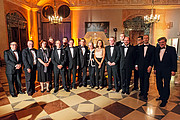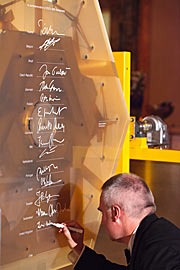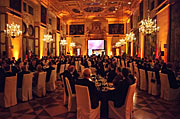Press Release
Gala Event Celebrates 50 Years of the European Southern Observatory
12 October 2012
On the evening of 11 October 2012 a gala event to celebrate the 50th anniversary of the European Southern Observatory took place in the Kaisersaal of the Munich Residenz in Germany. To mark the occasion, senior representatives of the ESO Member States and its host nation Chile, among them seven Ministers and two Ambassadors, and of the observatory itself, signed a prototype mirror segment of the European Extremely Large Telescope.
ESO's Director General, Professor Tim de Zeeuw, and the President of the ESO Council, Professor Xavier Barcons, welcomed distinguished representatives from the ESO Member States and the host country Chile, as well as the ESO Council, representatives of ESO committees, past ESO Directors General, renowned astronomers and other key figures from ESO’s history.
The gala event [1] celebrated fifty years of achievements since the signing of the ESO convention in October 1962, which established the organisation. Over the last half century ESO has become the world’s most productive ground-based astronomical observatory by far, and the event was an opportunity to celebrate the contributions of many of the key individuals and organisations who have been instrumental in ESO’s success.
Opening the event, Professor Barcons said “Working together as members of ESO is a vital way for the Member States to develop and build large-scale state-of-the-art astronomical facilities which we couldn't build individually, and also demonstrates how the spirit of scientific collaboration transcends national borders.”
Welcoming the guests to Germany, Professor Dr Annette Schavan, Bundesministerin für Bildung und Forschung said, “The research carried out by ESO is world-class, and we also want to keep this leading position in the future. Success stories live on by continuing to be told, and that is why it is important to carry out the construction of the largest optical telescope in the world, the European Extremely Large Telescope. The E-ELT could give us answers to some of the most pressing questions in astrophysics.”
“Within Bavaria’s fertile research landscape ESO is an outstanding and precious landmark,” added Dr Wolfgang Heubisch, MdL Staatsminister für Wissenschaft, Forschung und Kunst, Bayern, Germany. “It contributes to Bavaria’s reputation as an important site for science and attracts a large number of top scientists from around the globe.”
Among the eminent scientists at the gala was Professor Brian Schmidt, 2011 Nobel Laureate in Physics, who summed up his view on ESO as “I do not just see that the future of astronomy is bright at ESO, rather I see that the future of astronomy is ESO.”
Professor Tim de Zeeuw talked about the evolution of ESO and its three current observatory sites, La Silla, Paranal, and Chajnantor, as well as Armazones, the site of the future European Extremely Large Telescope. The facilities are the successful embodiment of the organisation’s mission to develop and operate world-class observing facilities for astronomical research, and to support collaborations in astronomy.
“ESO’s success is achieved by its motivated and highly-skilled staff, coupled with vital efforts from industrial, scientific and technical institutions in the Member States,” declared Professor de Zeeuw.
Professor de Zeeuw also looked to the future of both ESO and astronomy, and emphasised the ongoing importance of scientific research for society, noting “If our society does not remain interested in science, it is doomed. There has to be an element of blue-sky thinking and fundamental research.”
Guests also watched excerpts from Europe to the Stars — ESO's first 50 years of Exploring the Southern Sky, a documentary film that tells ESO’s story of designing, building and operating the most powerful ground-based telescopes on the planet.
To round off the evening the heads of the national delegations, and Professors de Zeeuw and Barcons, signed a prototype mirror segment for the European Extremely Large Telescope, the world’s biggest eye on the sky. The E-ELT’s 39-metre-diameter primary mirror will be composed of 798 such hexagonal glass segments, each 1.4 metres across but only 50 millimetres thick. The E-ELT will be by far the world's largest optical and near-infrared telescope. The signatures on this segment will be engraved into the glass, making a permanent memento of this celebration of ESO’s first 50 years.
Speaking after the signing ceremony, Chilean Foreign Minister, Alfredo Moreno, said “Chile's astronomical sites are the clearest on Earth, making them a wonderful gateway to explore the southern skies, and Chile’s strong scientific and technical community is a key support for the development of astronomical research. We are very proud to be the host nation of ESO, and to mark 50 years working together to advance our understanding of the Universe.”
Notes
[1] The gala event is one of several activities dedicated to ESO’s anniversary. Further information is available online.
More information
The year 2012 marks the 50th anniversary of the founding of the European Southern Observatory (ESO). ESO is the foremost intergovernmental astronomy organisation in Europe and the world’s most productive ground-based astronomical observatory by far. It is supported by 15 countries: Austria, Belgium, Brazil, Czechia, Denmark, France, Finland, Germany, Italy, the Netherlands, Portugal, Spain, Sweden, Switzerland and the United Kingdom. ESO carries out an ambitious programme focused on the design, construction and operation of powerful ground-based observing facilities enabling astronomers to make important scientific discoveries. ESO also plays a leading role in promoting and organising cooperation in astronomical research. ESO operates three unique world-class observing sites in Chile: La Silla, Paranal and Chajnantor. At Paranal, ESO operates the Very Large Telescope, the world’s most advanced visible-light astronomical observatory and two survey telescopes. VISTA works in the infrared and is the world’s largest survey telescope and the VLT Survey Telescope is the largest telescope designed to exclusively survey the skies in visible light. ESO is the European partner of a revolutionary astronomical telescope ALMA, the largest astronomical project in existence. ESO is currently planning the 39-metre European Extremely Large optical/near-infrared Telescope, the E-ELT, which will become “the world’s biggest eye on the sky”.
Links
- ESO’s 50th Anniversary
- 50 Highlights from 50 years
- Europe to the Stars — ESO’s first 50 years of exploring the southern sky
- More about the European Extremely Large Telescope (E-ELT)
- ESO’s telescopes
Contacts
Douglas Pierce-Price
Public Information Officer, ESO
Garching bei München, Germany
Tel: +49 89 3200 6759
Email: dpiercep@eso.org
Our use of Cookies
We use cookies that are essential for accessing our websites and using our services. We also use cookies to analyse, measure and improve our websites’ performance, to enable content sharing via social media and to display media content hosted on third-party platforms.
ESO Cookies Policy
The European Organisation for Astronomical Research in the Southern Hemisphere (ESO) is the pre-eminent intergovernmental science and technology organisation in astronomy. It carries out an ambitious programme focused on the design, construction and operation of powerful ground-based observing facilities for astronomy.
This Cookies Policy is intended to provide clarity by outlining the cookies used on the ESO public websites, their functions, the options you have for controlling them, and the ways you can contact us for additional details.
What are cookies?
Cookies are small pieces of data stored on your device by websites you visit. They serve various purposes, such as remembering login credentials and preferences and enhance your browsing experience.
Categories of cookies we use
Essential cookies (always active): These cookies are strictly necessary for the proper functioning of our website. Without these cookies, the website cannot operate correctly, and certain services, such as logging in or accessing secure areas, may not be available; because they are essential for the website’s operation, they cannot be disabled.
Functional Cookies: These cookies enhance your browsing experience by enabling additional features and personalization, such as remembering your preferences and settings. While not strictly necessary for the website to function, they improve usability and convenience; these cookies are only placed if you provide your consent.
Analytics cookies: These cookies collect information about how visitors interact with our website, such as which pages are visited most often and how users navigate the site. This data helps us improve website performance, optimize content, and enhance the user experience; these cookies are only placed if you provide your consent. We use the following analytics cookies.
Matomo Cookies:
This website uses Matomo (formerly Piwik), an open source software which enables the statistical analysis of website visits. Matomo uses cookies (text files) which are saved on your computer and which allow us to analyze how you use our website. The website user information generated by the cookies will only be saved on the servers of our IT Department. We use this information to analyze www.eso.org visits and to prepare reports on website activities. These data will not be disclosed to third parties.
On behalf of ESO, Matomo will use this information for the purpose of evaluating your use of the website, compiling reports on website activity and providing other services relating to website activity and internet usage.
Matomo cookies settings:
Additional Third-party cookies on ESO websites: some of our pages display content from external providers, e.g. YouTube.
Such third-party services are outside of ESO control and may, at any time, change their terms of service, use of cookies, etc.
YouTube: Some videos on the ESO website are embedded from ESO’s official YouTube channel. We have enabled YouTube’s privacy-enhanced mode, meaning that no cookies are set unless the user actively clicks on the video to play it. Additionally, in this mode, YouTube does not store any personally identifiable cookie data for embedded video playbacks. For more details, please refer to YouTube’s embedding videos information page.
Cookies can also be classified based on the following elements.
Regarding the domain, there are:
- First-party cookies, set by the website you are currently visiting. They are stored by the same domain that you are browsing and are used to enhance your experience on that site;
- Third-party cookies, set by a domain other than the one you are currently visiting.
As for their duration, cookies can be:
- Browser-session cookies, which are deleted when the user closes the browser;
- Stored cookies, which stay on the user's device for a predetermined period of time.
How to manage cookies
Cookie settings: You can modify your cookie choices for the ESO webpages at any time by clicking on the link Cookie settings at the bottom of any page.
In your browser: If you wish to delete cookies or instruct your browser to delete or block cookies by default, please visit the help pages of your browser:
Please be aware that if you delete or decline cookies, certain functionalities of our website may be not be available and your browsing experience may be affected.
You can set most browsers to prevent any cookies being placed on your device, but you may then have to manually adjust some preferences every time you visit a site/page. And some services and functionalities may not work properly at all (e.g. profile logging-in, shop check out).
Updates to the ESO Cookies Policy
The ESO Cookies Policy may be subject to future updates, which will be made available on this page.
Additional information
For any queries related to cookies, please contact: pdprATesoDOTorg.
As ESO public webpages are managed by our Department of Communication, your questions will be dealt with the support of the said Department.







